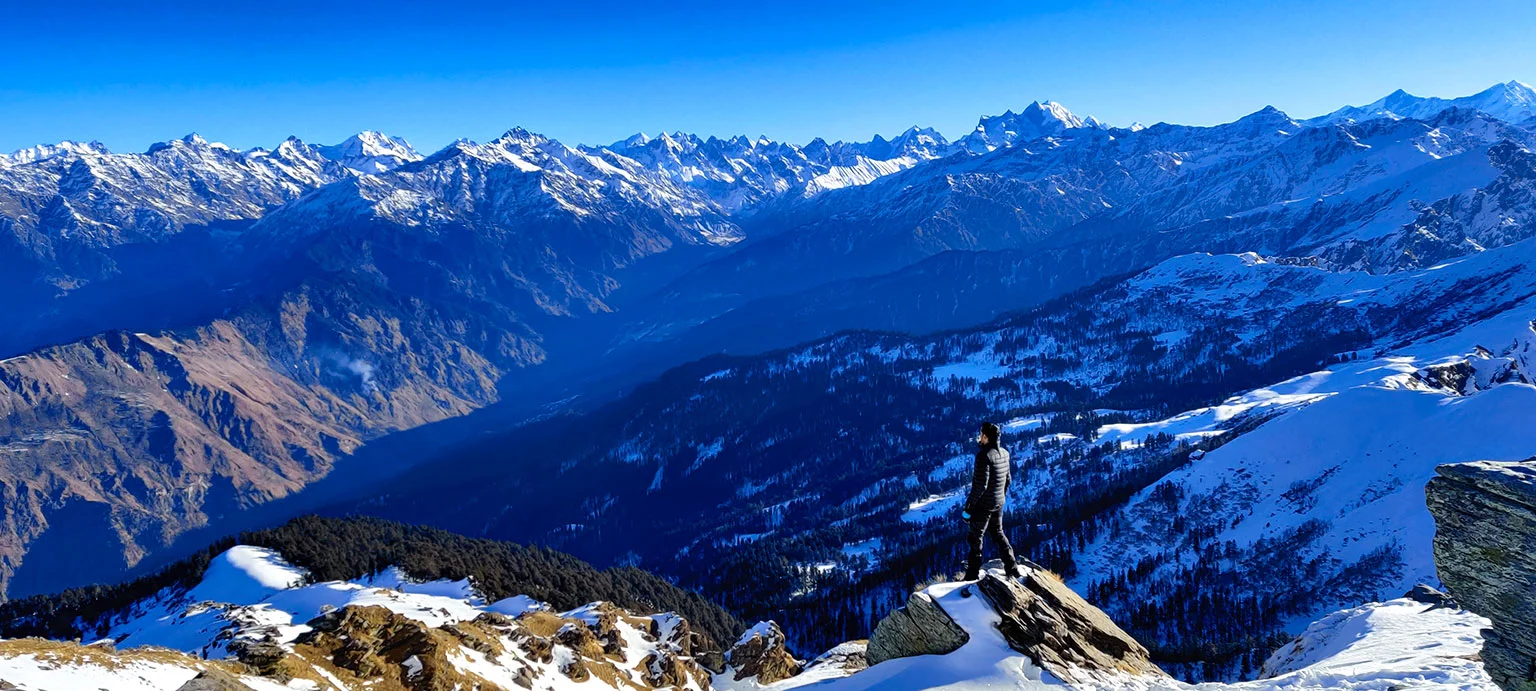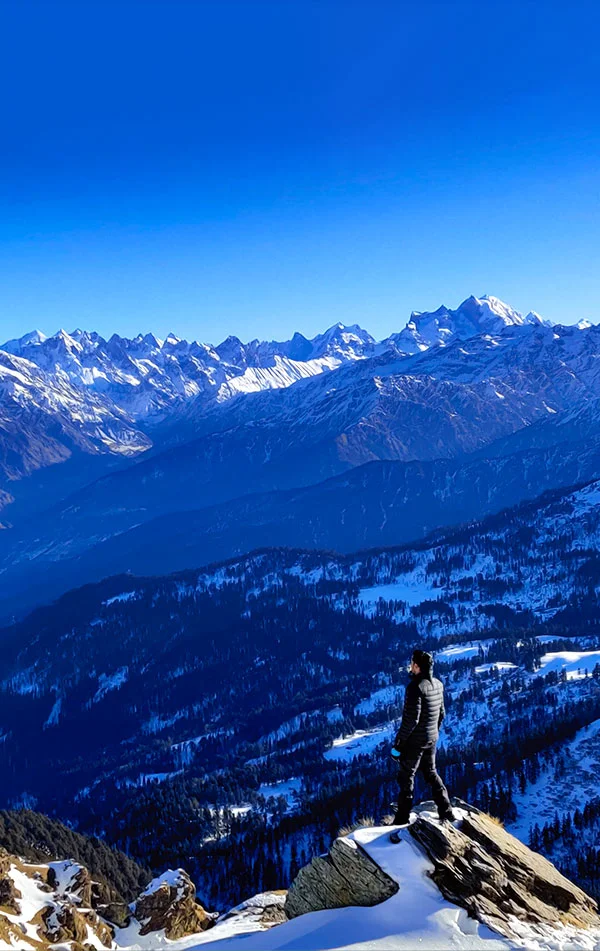
Region
Uttarakhand | India
Duration
6 Days
Max Altitude
12500 Ft.
Trekking Km
20 KM
Grade
Easy to Moderate
Help & Support
+91 8191004846 info@trekthehimalayas.com10:00 hrs to 18:00 hrs | GMT +5:30
Monday - Saturday | Sunday Closed
9500 /Person
- +5% GST (goods and services tax)
- Services Sankari to Sankari
- Addons
-
Insurance is Mandatory.
-
Non-Indian rates are slightly higher. Trek coordinator will provide balance payment link post-booking.
- Get insurance through us or elsewhere. If not through us, email for a refund after booking.
-
Cancellation 4 or more days before the start of the trip results in a 100% cash refund.
-
Cancellation less than 4 days from the start of the trip results in no refund.
-
Transportation Dehradun to Sankri & retun is optional
-
Choose add-ons during booking. If missed, log in and add them later
-
Book transportation at least 10 days before the trek.
-
Cancellation 4 or more days before the start of the trip results in a 100% cash refund.
-
Cancellation less than 4 days from the start of the trip results in a 50% cash refund.
-
Cancellation after the trip date does not qualify for a refund.
-
Backpack offload is optional
-
Choose add-ons during booking. If missed, log in and add them later.
-
Book off-load at least 10 days before the trek.
-
For offline bookings at the base camp, a convenience fee of Rs. 1800 applies.
-
Cancellations made before the trip date will receive a full refund.
Insurance 210
Transport 1600
Offload 1200
For more information. Please complete this form.
Help & Support
+91 991 772 4737info@trekthehimalayas.com 10:00 hrs to 18:00 hrs | GMT +5:30
Monday - Saturday | Sunday Closed
Overview
Trek Name: Kedarkantha Peak Trek
Days: 6
Adventure Type: Trekking
Base Camp: Sankri
Season:Spring | Winter |
Month:January | February | March | April | November | December |
Country: India
Altitude: 12500 Ft.
Grade: Easy to Moderate
Rail Head: Dehradun
Stay: Camping (Twin sharing) & Hotel/Guesthouse
Food: Meals while on trek & at Hotel/Guesthouse (Veg & Eggs)
Location: Uttarakhand
Distance: 20 Km.
Trail Type: Circle trail | Camping in various locations, starting and ending at the same point.
AirPort: Jolly Grant Airport, which is 28 km away from Dehradun
Highlights:
- +5% GST (goods and services tax)
- Services Sankari to Sankari
Why Kedarkantha Is A Must Do Trek
The Winter Kedarkantha Trek is a quintessential high-altitude winter trek in the Indian state of Uttarakhand. It offers a unique opportunity to explore the snow-covered landscapes of the Himalayas. The easy endurance of the trail makes it suitable for both beginners and seasoned trekkers. The spellbinding views from the summit make the 12,500 ft climb totally worth it. The trek also consists of some of the most beautiful campsites, in the vicinity of pine covers and amidst the snow. You can witness stunning sunrises and sunsets from your campsites and bask in the tranquillity of nature. The view from the summit is unlike anything youve ever seen. You can view the majestic Yamunotri and Gangotri peaks along with the Black Peak, Bandarpoonch, and the Swargarohini group of peaks.
Highlights
The Forests
The Pine and Oak forest cover in Kedarkantha is one of the Kedarkantha trails. This adds to the beauty of the trek and creates an aura of serenity. These are some of the most pristine alpine forests and being a forest cover at such a high altitude, they do not appear manicured but rather have a Kedarkantha Peak Trek touch to them. In some places, the forest cover is pretty dense giving a very surreal feel to your climb.
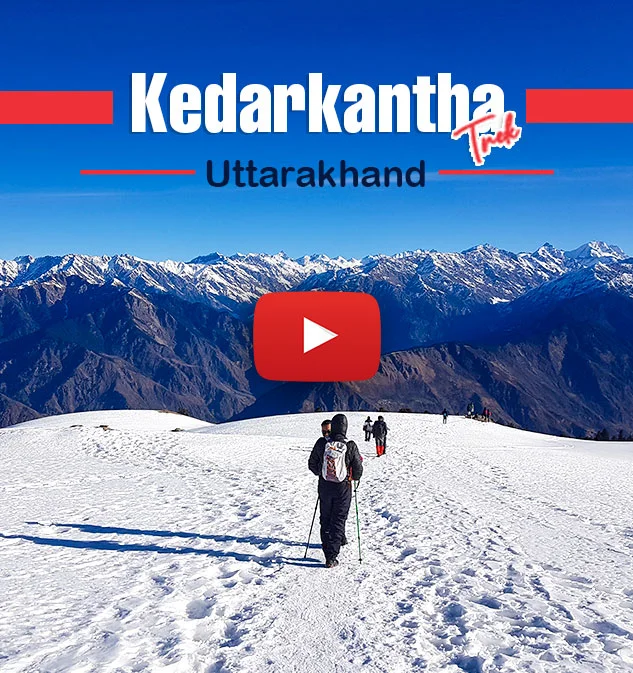
Who Can Participate
-
Age; 12 years +.
-
First timers can apply; previous trekking experience is more appreciated.
-
The climber must be fit and have sufficient stamina to cover 5 km of distance in 30 minutes without stress.
-
The climber should be able to carry a 10-15 kg backpack.
-
Pulse rate at rest must be in between (60 to 90 beats per minute)
-
Blood Pressure Reading must be in between (DIASTOLIC 70 – 90, SYSTOLIC 100 - 140 mm Hg)
-
Respiratory rate at rest must be in between (12 to 20 breaths per minute)
-
Should not have Liver and kidney issues
-
Should not have Diabetes Mellitus, Bronchial Asthma, Heart problems, Hypertension etc
-
No pacemaker implant
-
People with the Sinus issues, Epilepsy please contact to trek coordinator before booking the trek
-
If your BMI is not normal, Please contact our Trek coordinator before Trek booking.
Medical & Disclaimer Form (Mandatory Documents) Click here to download Medical & Disclaimer Form
- Government Employees can avail the benefit of Special Casual Leave (SCL) when you join us for a trekking expedition. As per the rules of the Pay Commission, Special Casual Leave can be availed for up to 30 days in a calendar year for trekking/mountaineering expeditions through a registered organization. Trek The Himalayas is a registered adventure tour operator by Indian Mountaineering Foundation (IMF) and Ministry Of Tourism (MOT)
- Trekkers have to apply for leave at least 20 days before trek departure date,
- This service is exclusive to Indian government employees and is applicable only for treks within India.
- Do mail at info@trekthehimalayas to apply and mention your booked trek date and trek name.
- Junior trekkers (below 15 years) should have a company of parents/guardians.
- Trekkers between 15 to 18 years can come solo with the disclaimer form signed by parent/guardian.
- Medical & Disclaimer Form (Mandatory Documents) Click here to download Medical & Disclaimer Form
Itinerary
Arrival at Sankri
Our journey starts from Dehradun where we will pick you up in Tata Sumo or similar vehicles at 6:30 AM. You are requested to report at the pickup point by the time. From Dehradun, we will drive to Sankri, which is at a distance of 220 km from Dehradun. It may take about 8 - 9 hrs or more to reach Sankri as the mountain roads can be quite bumpy at times. However, the road to Sankri is quite scenic.
On your way, you will cross picturesque places like Mussoorie, Mori, and Naitwar, etc. You will drive along the beautiful Yamuna and Tons River with pine trees lining the road. The River is milky white in some places and clear green in others. The fragrance of pinewood and the beauty of nature will make up for the long ride to Sankri. The last stretch of the road, about 22 km from Sankri, is even more beautiful as you enter the Govind National Park, famous for being home to much exotic flora and fauna. On reaching Sankri, we will check-in at our hotel. After freshening up, you can spend the evening at the quaint hamlet of Sankri at your leisure.
You can head out for a stroll through this charming village. Sankri is a trekkers’ hub as it is the base camp for not one or two but 11 Himalayan treks including popular treks like Har Ki Dun. At Sankri BSNL network is available but it is very erratic. You can also watch a beautiful sunset at Sankri Village in the backdrop of the Himalayas, a great opportunity for shutterbugs to capture all the beauty around. At night, you can have dinner at your hotel or in the local village dhabas to get a taste of the local flavors. Stay overnight at Sankri and we will start our trek the following day.
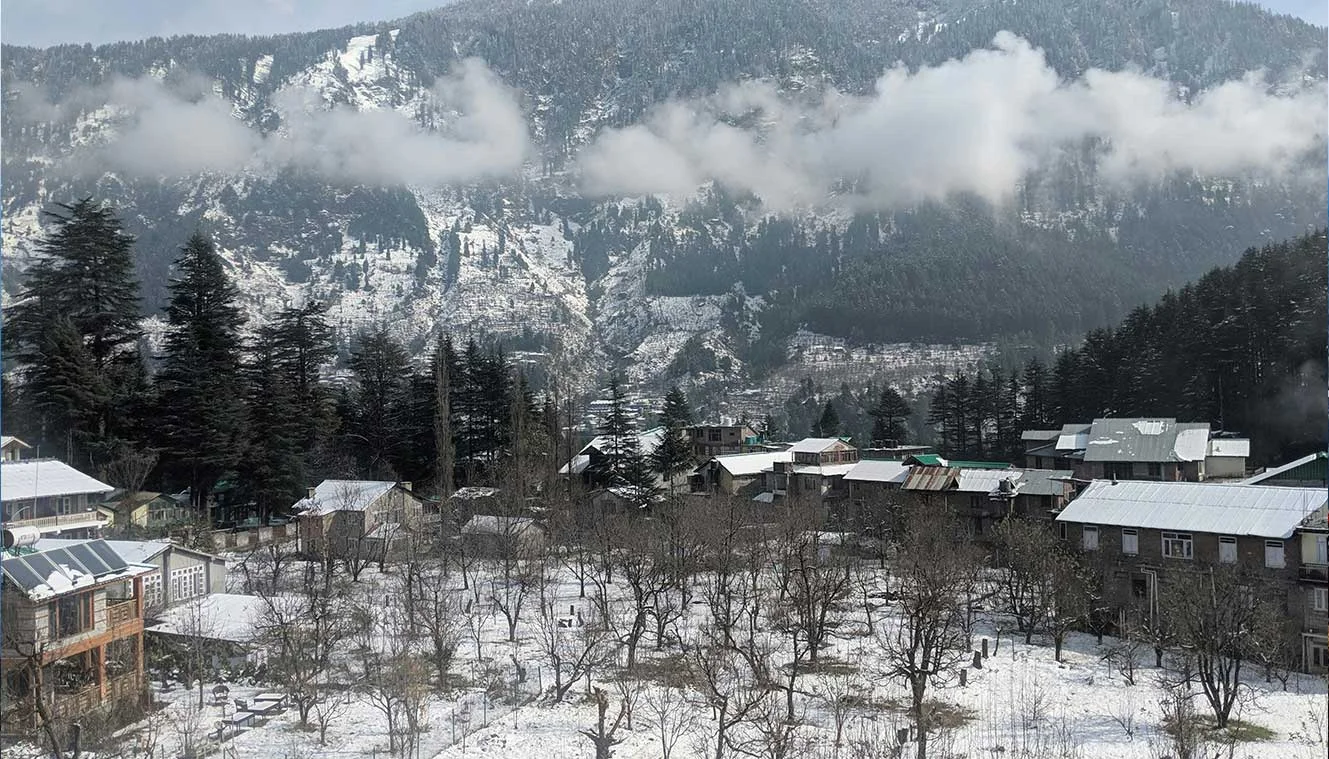
Sankri to Juda-ka-Talab
Trekking for the Kedarkantha summit starts at Sankri, our base village for the trek, and today we will trek from here to Juda Ka Talab, a beautiful alpine lake. Start your day early, have your breakfast and head out straight towards Juda Ka Talab. The lake is situated at an altitude of 9100 ft and the trek distance is about 4 km. It will take approximately 5 hours to reach the Lake.
As you begin your trek out of Sankri village, you will venture into the village extension Saur and from here you will walk along a stream, and then we will take a turn towards the forest of pine and maple, climbing sharply. We will cross many suspension bridges and small mountain villages on our way to Juda Ka Talab.
The trail today is quite broad and ascends gradually for about 2-3 hours. During summers, the trail is full of greenery and you will spot many wildflowers on your way. A carpet of maple and pine leaves covers the trail and opens up to lush green meadows. During winter, the trail is covered in snow, and depending on the snow conditions, you may need gaiters to navigate the path properly. As you trek uphill, you may also spot wildlife in the trail like the Himalayan Languors. While they are quite shy, they move pretty quickly, swinging from branch to branch, so its hard to catch a proper glimpse of them. Apart from this, you may also spot boars, hares, and martens.
The Juda Ka Talab campsite is extremely scenic with an alpine lake on one side and a pine forest on the other, it almost feels surreal here. In the lap of mountains and the middle of pine and snow, the surreal beauty of Juda Ka Talab is simply otherworldly. During peak winters, a sheet of ice forms on the lake, creating a picture-perfect view. The lake also has a natural tunnel that provides water to the villagers nearby. The locals consider the lake as sacred and believe that Lord Shiva meditated at Kedarkantha and droplets falling from his hair formed the lake.
We will camp here for the night. You can click some beautiful pictures here and also take nature walks in the area. At night, a bonfire is a great idea to relish your dinner and warm drinks, chatting up with your fellow trekkers. The night sky is simply breathtaking with an assortment of the brightest stars dazzling the sky. Sleep overnight in your tents.
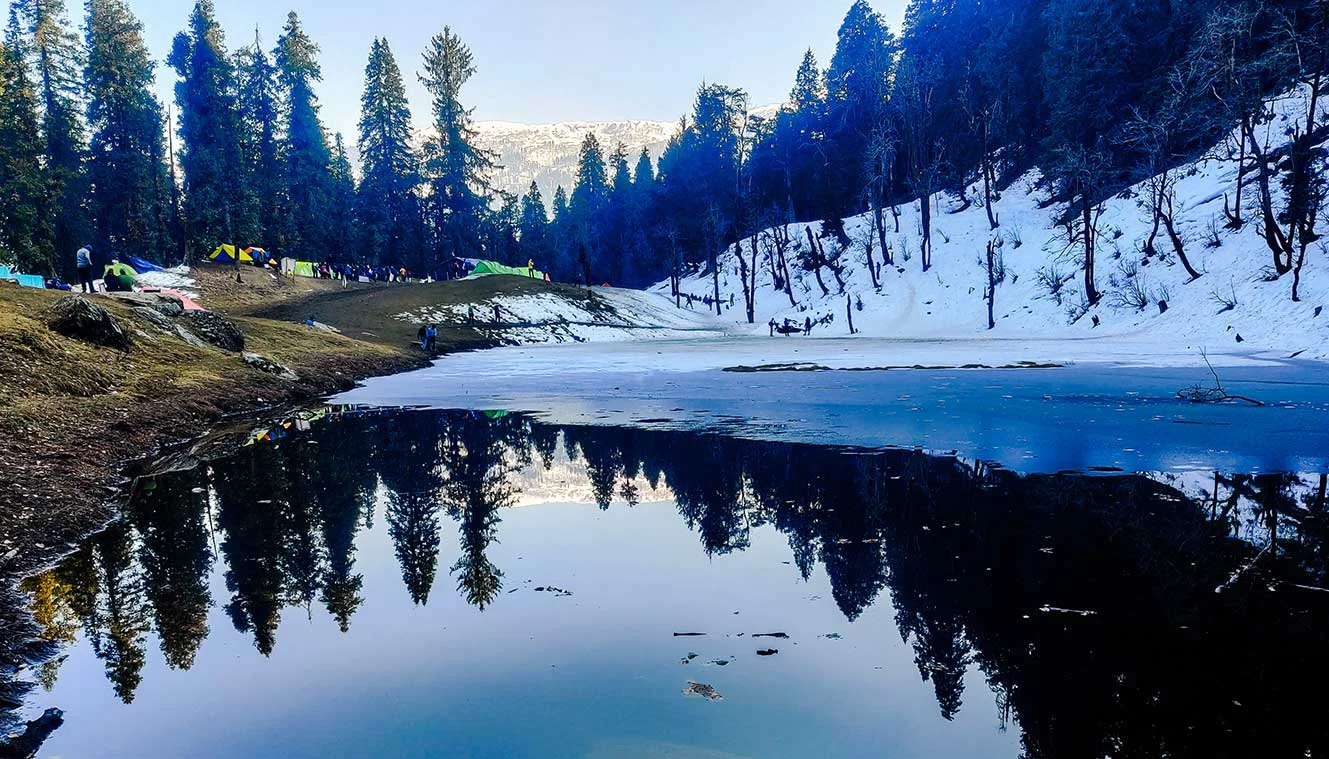
Juda-ka-Talab to Kedarkantha Base
Starting the day early, we will begin our day with a warm breakfast and a glorious sunrise view and begin the trek towards the Kedarkantha Base Camp. The base camp is located at an altitude of 11,250 ft and the distance from Juda Ka Talab to the base camp is 4 kms. Walking moderately, you can reach the base camp in about 3 hrs. The trail is marked quite well so it is quite easy to navigate. The trail is a little steeper than the previous day and it gradually becomes steeper as you get closer to the summit.
Walking through this trail, you will soon enter a forest Pine and Oak which soon opens into expansive meadows. The meadow is lined with shepherd huts and as you move forward you will catch the sight of towering Himalayan peaks Swargrohini peaks, Bandarpoonch, Ranglana, Kala Nag, etc. The splendid views are enough to render you speechless. The peaks appear as if natural jewels adorned by Mother Nature and the views will be forever imprinted in your memory.
The Kedarkantha trail is fairly easy and beginner-friendly and even in the peak winter, it isn’t as strenuous as other treks making it enjoyable for everyone. You can see the trail covered in snow here during the winter months, in summer it is luscious green. Once you reach the campsite, you can rest and refresh yourself and take small walks around the campsite. At night enjoy a nice and hot dinner and observe the beauty of the clear night sky with an abundance of twinkling stars, glowing brightly.
At such a high altitude, the cold waves can be pretty high, so it is recommended you layer appropriately for protection against cold. Retire in your tents early, to get proper rest for the summit trek the next day.
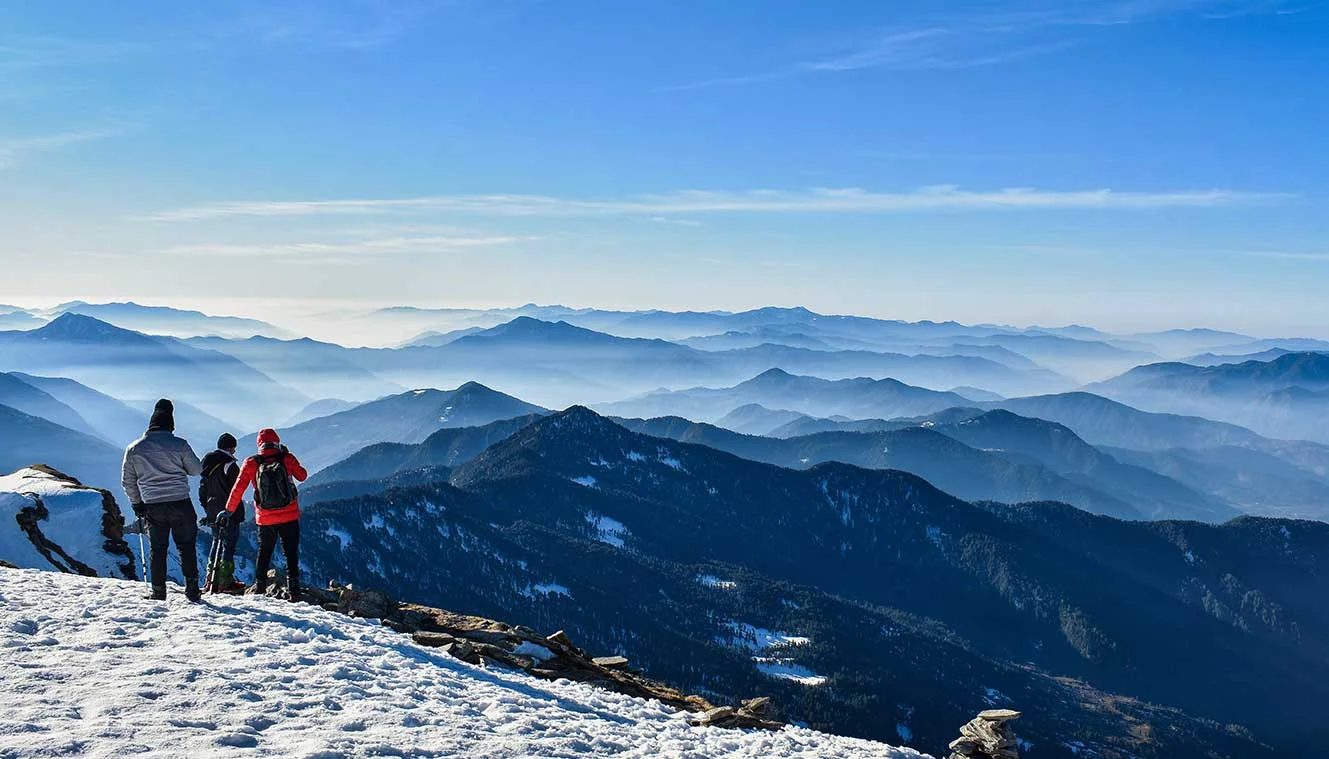
Kedarkantha base to Kedarkantha peak; descend to Hargaon camp
Today we will trek to the Kedarkantha summit reaching an elevation of 12,500 ft. Today’s trekking schedule involves trekking from the base camp to the Kedarkantha summit and descending to the Hargaon campsite. The journey to the summit and down to Hargaon is about 6 km and it takes about 7 hr.
After a pleasant breakfast in the morning, we will set out for the Kedarkantha summit. The trek is a gradual incline, however, it gets pretty steep in the end and might test your skills and fitness a little. Today also your trek will begin by crossing a forest of towering Oaks and Pines. The leaves strewn on the ground, scrunching your feet and you can also hear the faint sounds of streams gushing by.
Soon the forests open up and you are much closer to the peak now and from here the path will begin to get difficult as a sharp incline lies in front of you. But the struggle to reach the top is worth it once you make it to the summit and the marvelous views of the Himalayas await you. You will literally feel like being on top of the world and filled with a sense of accomplishment and inner peace. The astounding views will rejuvenate you after the strenuous journey. There’s also a small temple of Lord Shiva, Goddess Parvati, and Lord Ganesha at the summit.
After enjoying the picturesque views and basking in nature’s abundance, we will start descending and trek downhill to the Kedarkantha base camp where we will have our lunch, and post-lunch we will begin descending downhill, all the way to Hargaon. The descent is quite easier and faster and soon you will reach the campsite at Hargaon, descending to an elevation of 8900 ft. Reaching the Hargaon campsite marks the end of our day, we will set up camps here, enjoy a nice dinner and retire in our tents for the night.
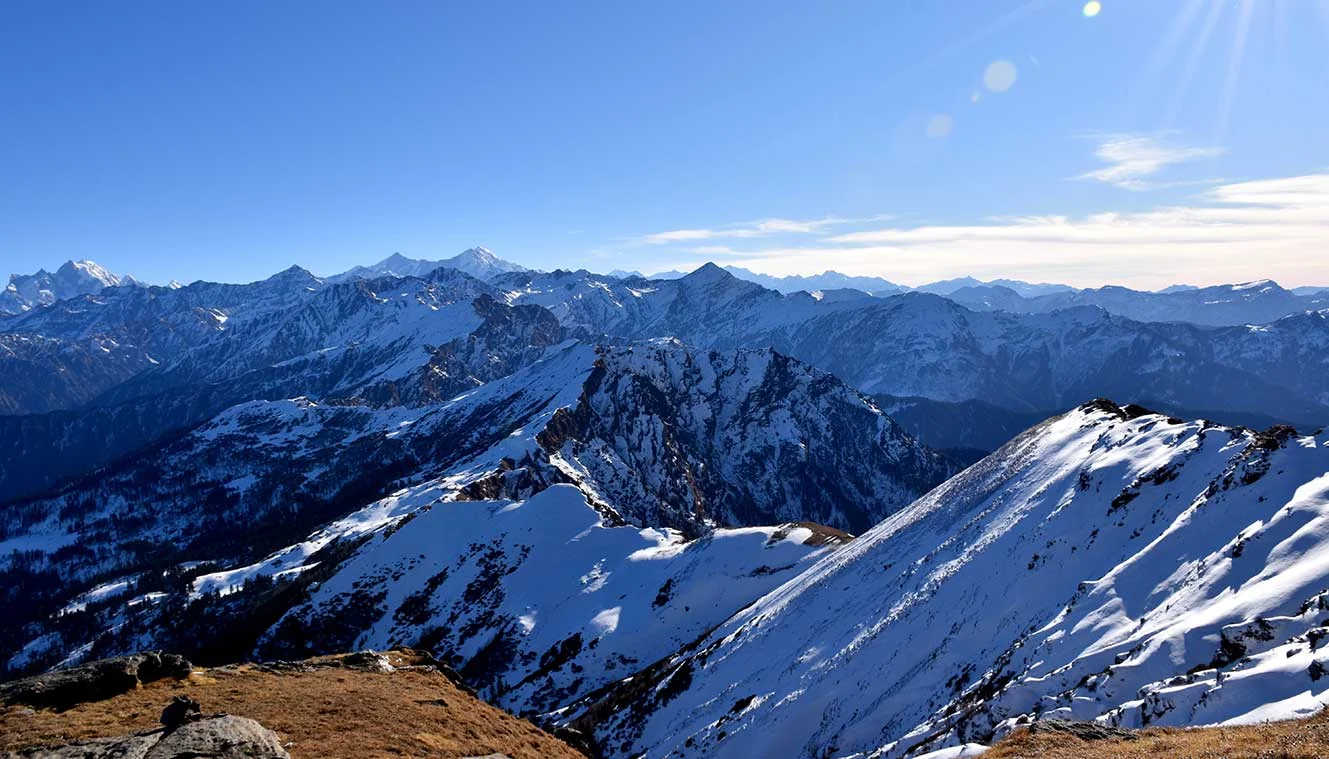
Hargaon camp to Sankri
The final leg of the trek involves descending from Hargaon to Sankri. We will descend from an altitude of 8900 ft to 6400 ft and the trek distance is about 6 km. It takes approx 3 to 4 hours to complete the descent.
Rise with the sun and enjoy a scrumptious breakfast. The sunrise in the Himalayas has a unique splendor, which is quite hypnotizing. After breakfast, we will begin our descent towards Sankri. You will trek through forests and gurgling streams. You can fill your water bottles in the streams. Soon the forest opens up to a ridge from where you get a birds eye view of the Har ki Dun Valley.
The brilliance of the lush green slopes of the Valley is simply wonderful. Relishing the view, we will descend further as the forest grows denser once again and finally opens up at Sankri. At Sankri we will check-in at the hotel once again. You can freshen up and in the evening, you can head out to explore the village.
Although there aren’t many shops at Sankri, you can still buy wooden handicraft items, toys, and home decors as souvenirs of your journey. Interact with the locals and get more ideas about the local lifestyle. Life at Sankri is pretty slow-paced and the religious belief is quite strong here. There are about 120 families in Sankri who live in wooden huts to protect themselves from the cold and the staples are potato rice and apples.
At Sankri they also hold regular fairs or melas where entertainment takes place in the form of singing and dancing to native folk songs. For dinner you can visit the dhabas, they serve some delicious cuisines or you can have dinner at the hotel premises as well. Stay overnight in the hotel after a tiring yet wonderful journey.
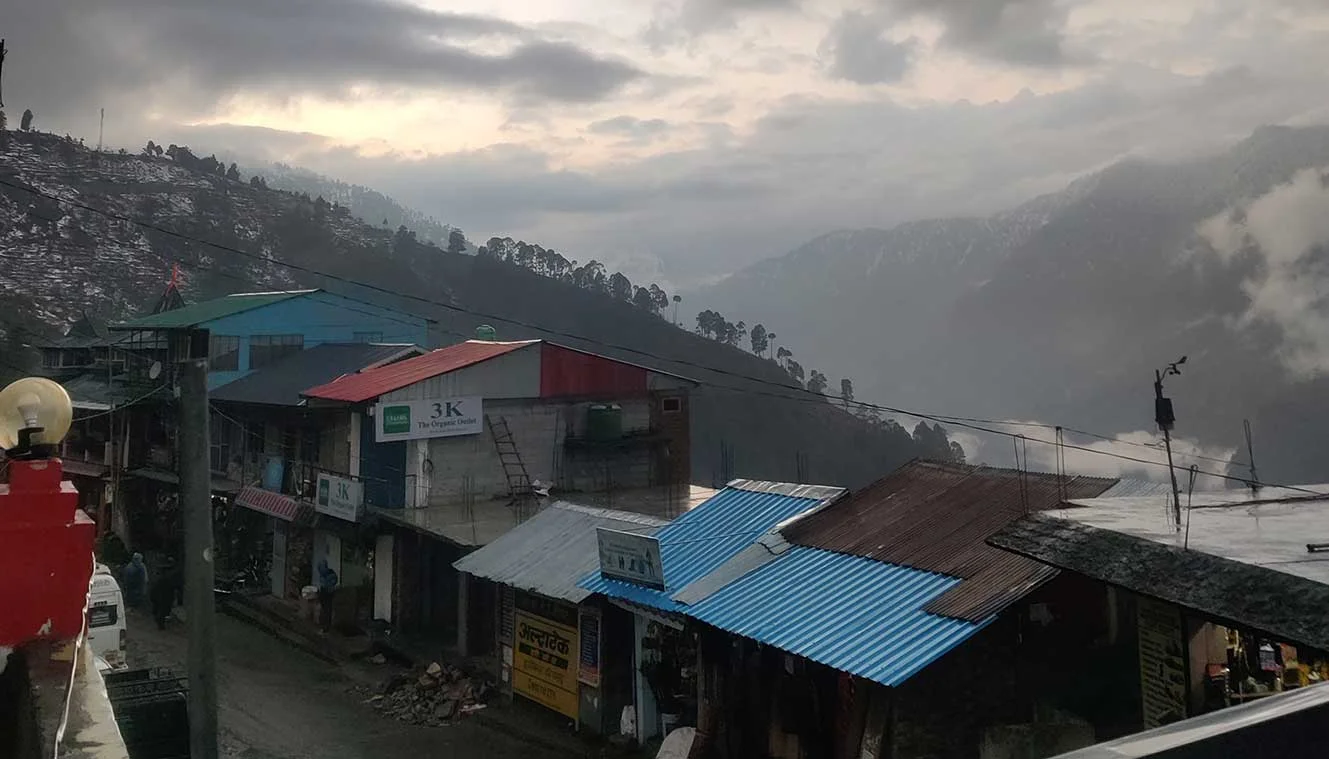
Departure day (Sankri to Dehradun)
On the last day of our wonderful trip, today we will head back to Dehradun with so many beautiful memories. Tata Sumo or other similar vehicles will be arranged for you at Sankri to drive you back to Dehradun. Check out from the hotel by 7:00 AM so that we can begin the journey to Dehradun early. We have to cover a distance of 220 km and it will take about 10 hrs so the earlier we start the better.
We will again return through NH 123, enjoying the scenic beauty. Cherish the nature around with picturesque vistas stretching alongside far and wide. We will reach Dehradun by 5:00 - 6:00 pm so make your further bookings accordingly.
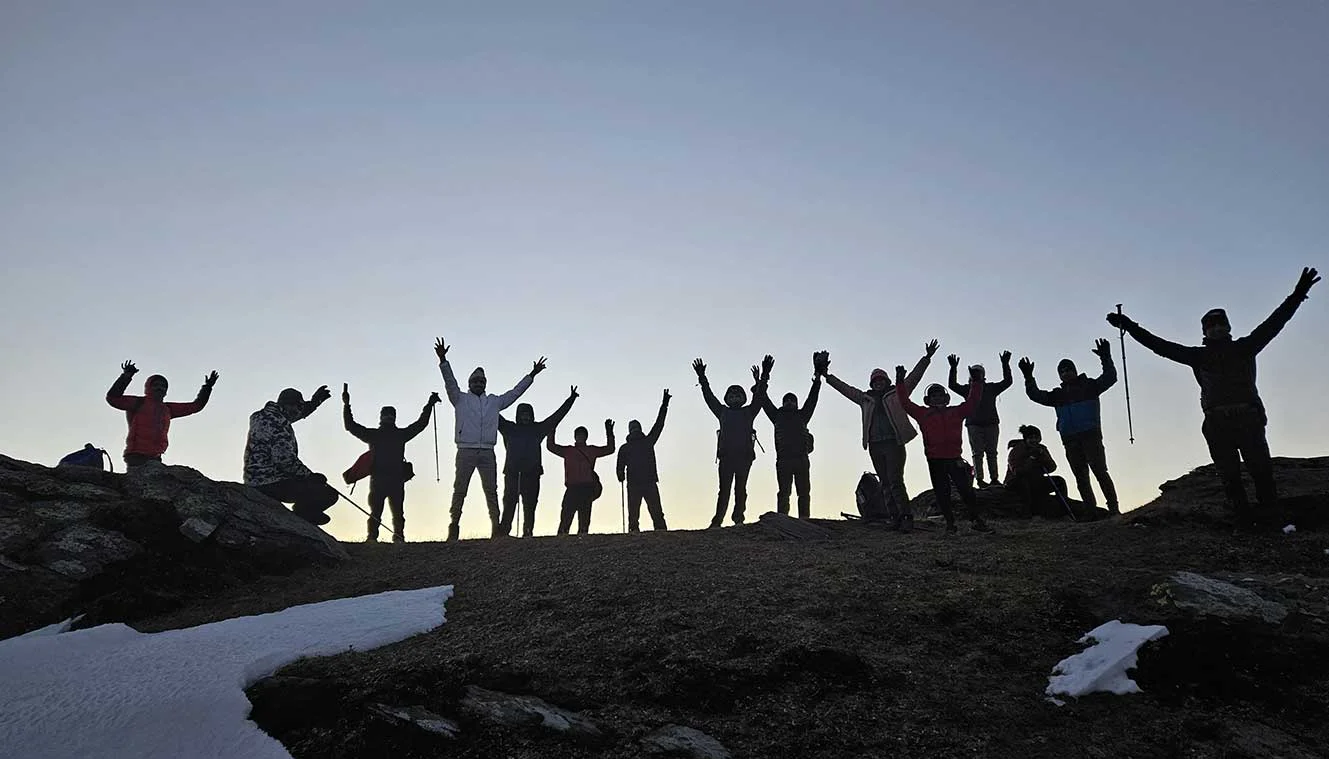
Day-1: Arrival at Sankri
- Altitude: 1,950m/ 6,400 feet.
- Drive Distance: 220 km (10 hr approx).
- Pickup: Dehradun at 6:30 AM.
- Type Of Vehicle: Tata Sumo/Tempo traveller or similar vehicle.
- Transportation Amount is not included in the trek cost.
- Network Available: BSNL.
- Arrival at Sankri: 5:00 PM.
- Stay in hotel, attached washroom with running water.
Day-2: Sankri to Juda-ka-Talab
- Altitude: 6400 ft - 9100 ft.
- Trek Distance: 4 km (5 hr approx.).
- Altitude Gain:- 800m/ 2,700ft.
- Trek through dense forests of maple and pine cross a few streams and beautiful meadows.
- Stay in tents, twin sharing.
Day-3: Juda-ka-Talab to Kedarkantha Base
- Altitude: 9,100 ft - 11,250 ft.
- Trek Distance: 4 km (2.5 hr approx.).
- Altitude Gain:- 650m/ 2,150ft.
- The trail on the ridge under Oak cover and pass through some meadows.
- Peaks Spotted: Bandarpoonch, Swargrohini peaks, Ranglana, and Kala Nag.
- Stay in tents, twin sharing.
Day-4: Kedarkantha base to Kedarkantha peak; descend to Hargaon camp
- Altitude: 11,250 ft - 12,500 ft - 8900 ft.
- Trek Distance: 6 km (7 hrs approx.).
- Altitude Loss:- 700m/ 2,350ft.
- Spend some time at the summit and descend back to basecamp for lunch.
- Post lunch descend to Hargaon.
- Stay in tents, twin sharing.
Day-5: Hargaon camp to Sankri
- Altitude: 8,900 ft - 6400 ft.
- Trek Distance: 6 km (7 hrs approx.)
- Altitude Loss:- 750m/ 2,500ft.
- Descend through dense pine thickets.
- Stay: in hotel, attached washroom with running hot water.
Day-6: Departure day (Sankri to Dehradun)
- Drive Distance: 220 km (10 hr approx.)
- Drop at Dehradun Station in Tata Sumo or a similar vehicle.
- Breakfast and Lunch are not included in the trek cost.
- You will reach Dehradun by 5:00 - 6:00 pm.
Note: Distance, Altitude and Trekking hours are approximate and round off.
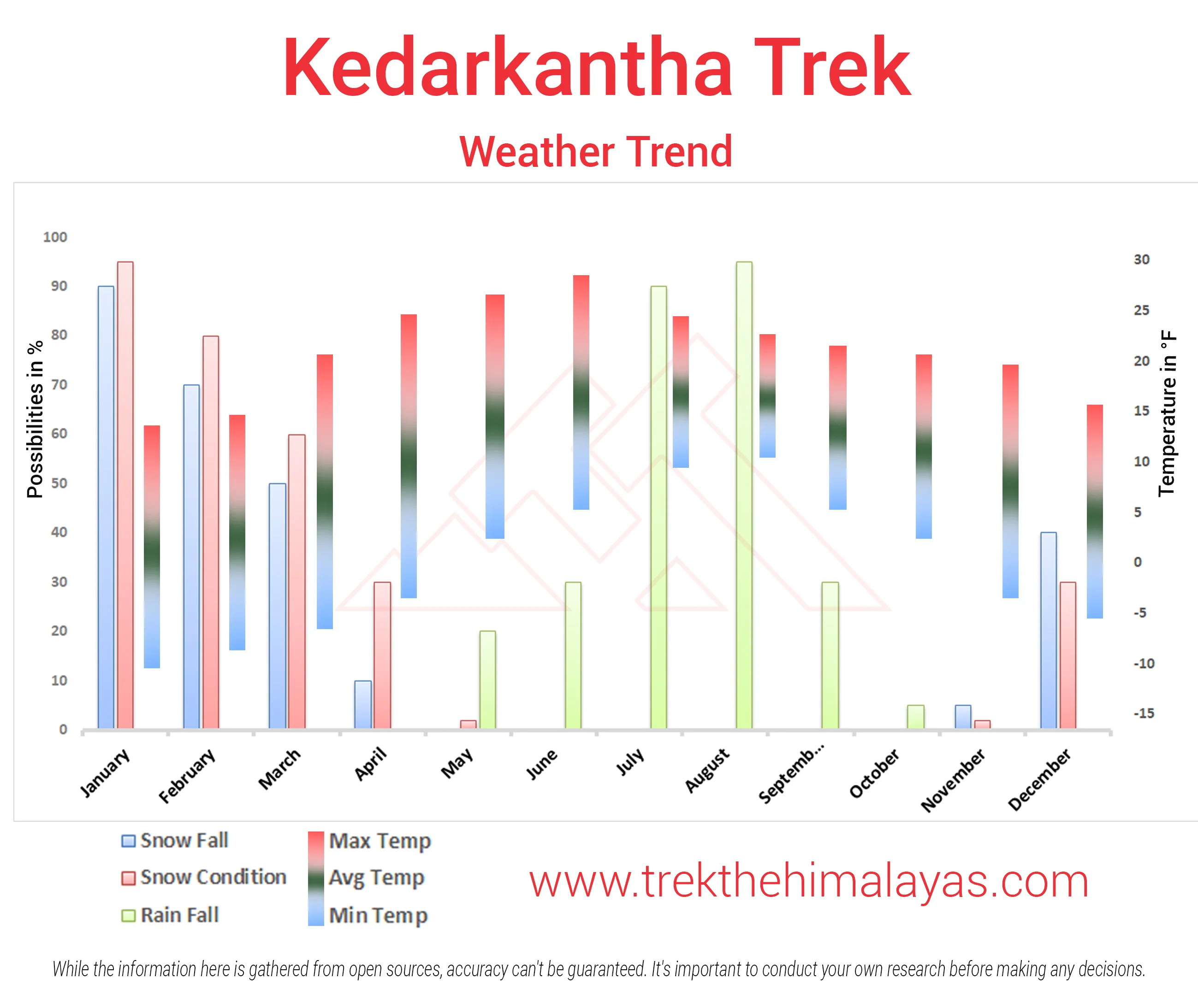
Important Links
Medical & Disclaimer Form (Mandatory Documents) Click Here.
How To Reach
It is essential for everyone to arrive at Dehradun (06:00 am).
Our pick-up location is Dehradun Railway Station at 06:00 AM
Once you have reached Dehradun, TTH will manage the rest of your travel arrangements, if you have opted for TTH's pick-up service, you can select this option during the booking process by adding it as an add-on.
The distance from the Dehradun Bus Stand (ISBT) to the Railway Station is 6 km, without traffic, it will take 15 minutes.
Note
- Transportation Amount is not included in the trek cost.
- Pick-up is excluded from the cost of the trek.
- TTH’s Tata Sumo, Tempo Traveller or similar vehicles will pick-up you.
- If you wish to upgrade the transport service, please contact the Trek Coordinator.
Options to reach Dehradun
1. Take an overnight train/bus to Dehradun, and then take a cab to the pickup point.
We always recommend to go for the govt. Buses over the private ones outside the bus station as based on the experience we have found that there are very high chances of delay involved with private buses. Also, govt. Buses are always more reliable. Whichever bus you choose, just make sure to reach Dehradun at least by 05:30 am positively.
2. Take flight to Dehradun airport (Jolly Grant Airport) (25 km, 50 min), if coming by flight then come one day early.
If you prefer to travel independently, you can either take a government bus or book a private cab. Your trek coordinator will provide guidance on how to arrange for the bus or cab booking.
Arrive in Dehradun Railway Station by 6:00 pm.
The designated drop-off point is Dehradun Railway station.
Please consider planning your subsequent travel arrangements after 8:00 pm.
The distance from Railway Station to Dehradun Bus Stand (ISBT) is 6 km, it will take approx 25 minutes.
The distance from Railway Station to Dehradun Airport is 28km, it will take approx 45min to 1hr.
TTH offers comfortable transportation through Tempo Traveler, Bolero, or equivalent vehicles. If you wish to upgrade your mode of transportation, please contact your trek coordinator for further assistance.
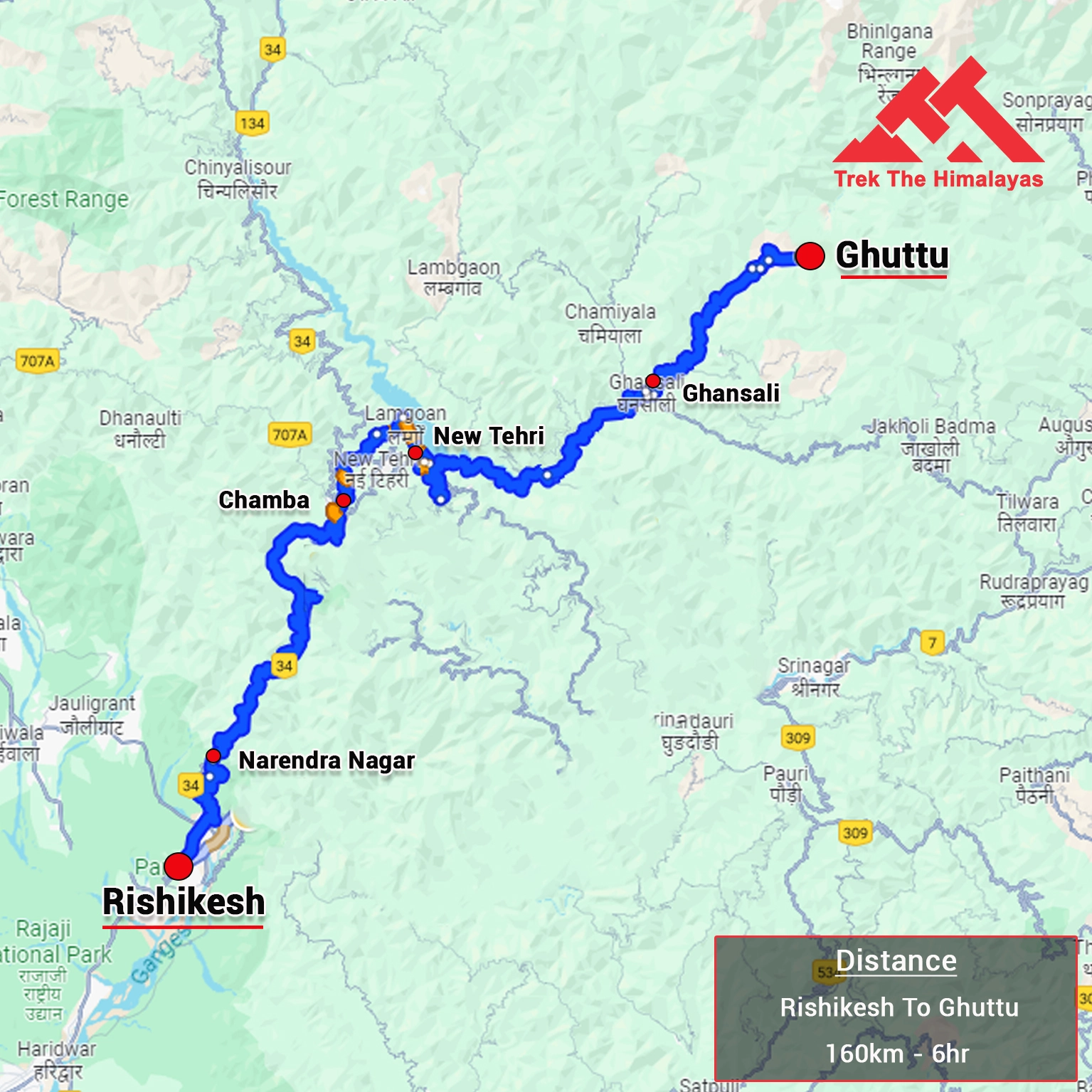
Cost Terms
Inclusion
1. Accommodation (as per the itinerary):
- Guest house - Triple/quad/penta sharing, Camping - twin sharing.
2. Meals (Veg + Egg):
- Day 1 Dinner to Day 5 Dinner as per the itinerary.
- Drinking water while on trek (Tape/Mountain water).
3. Support:
- 1 Versatile base camp manager: handles communication and deploys extra manpower in emergencies.
- 1 Mountaineering & First aid qualified professional trek Leader.
- 1 Experienced high altitude chef.
- Local experienced guides (Number of guides depending on the group size).
- Enough support staff.
4. Trek equipment:
- Sleeping bag, Sleeping liners (if required), Mattress, Utensils.
- 3 men all season trekker tent (twin sharing), Kitchen & Dining tent, Toilet tent.
- Camping stool, Walkie talkie.
- Ropes, Helmet, Ice axe, Harness, Gaiters & Crampon (if required).
5. First aid:
- Medical kit, Stretcher, Oxygen cylinder, Blood pressure monitor, Oximeter, Stethoscope.
6. Transportation (as per the itinerary):
- Transport from Dehradun to Sankri and return.
7. Mules/porters to carry the central luggage.
8. Clock room facility available at the base camp for additional luggage.
9. All necessary permits and entry fees, Upto the amount charged for Indian.
Exclusion
1. Insurance (Mandatory).
2. Food during the transit.
3. Any kind of personal expenses.
4. Mule or porter to carry personal luggage.
5. Emergency evacuation, hospitalization charge or etc.
6. Anything not specifically mentioned under the head Inclusion.
7. Transport cost.
Things can be provided on demand and availability (participant has to pay extra for these things).
1- Satellite phone/set phone - is a type of mobile phone that connects via radio links via satellites orbiting the Earth instead of terrestrial cell sites like cellphones. Therefore, they can operate in most geographic locations on the Earth's surface.
2- Gamow/PAC HAPO Bag (Portable Hyperbaric Bag) - is a unique, portable hyperbaric chamber for the treatment of acute mountain sickness (AMS), also known as altitude sickness.
3- AEDs (Automated External Defibrillators) - are portable life-saving devices designed to treat people experiencing sudden cardiac arrest, a medical condition in which the heart stops beating suddenly and unexpectedly.
Cancellation terms:
Cancellations prior to 25 days from the start of the Trip
Refund options
- 5% deduction of trek fee
- 100% cash voucher for any trip till one year
- Transfer your trek (any trek, any date) to your friend
Cancellation between 24 days and 15 days to the start of the Trip
Refund options
- 30% deduction of trek fee
- 100% cash voucher for same trip till one year
- 85% cash voucher for any trip till one year
- Transfer your trek (same trek, any date) to your friend
Cancellation between 14 days and 10 days to the start of the Trip
Refund options
- 50% deduction of trek fee
- 80% cash voucher for same trip till one year
- 70% cash voucher for any trip till one year
- Book the same trek, in the same season, with any other batch
- Transfer your trek (same trek, any date) to your friend
Cancellation less than 9 days to the start of the trek
Refund options
- No cash refund
- 20% cash voucher for the same trip till one year
- 10% cash voucher for any trip till one year
- Transfer your trek (same trek, same date) to your friend
Note- If a booking is made using a voucher or discount code, the policies related to vouchers and discounts cannot be modified.
In the unlikely event that TTH cancels a trek prior to the scheduled departure date:
While it is extremely rare for TTH to cancel a trek, we understand that unforeseen circumstances or natural disasters may occasionally require us to do so before the scheduled departure. These circumstances could include continuous rain or snow, thunderstorms, snowstorms, landslides, floods, earthquakes, or any other natural calamity that poses a risk to the safety of our trekkers. Additionally, unforeseeable events such as local riots, curfews, pandemics, lockdowns, government orders, or any similar situations that compromise the safety of the trekking experience may also necessitate a cancellation.
In the event of such a cancellation, TTH will provide you with a voucher equivalent to the amount you paid for the trek. This voucher can be redeemed for any of our treks within the next year, allowing you to still enjoy an adventure with us at a later date.
Note
-
The issuance of a voucher is not applicable in situations where you are required to descend from the trek for any reason. The trek leader may make the decision to send you down from the trek due to factors such as insufficient fitness level, symptoms of Acute Mountain Sickness (AMS), high blood pressure, exceeding the designated turn-around-time, health concerns, or if you are found smoking, drinking, or violating the rules set for the trek. In such cases, the provision of a voucher does not apply.
In the rare event that TTH shifts a trek:
We would like to emphasize that weather conditions in high-altitude areas are highly unpredictable and can undergo sudden changes at any time, irrespective of the day. Additionally, circumstances beyond our control, such as natural disasters, political unrest, pandemics, and lockdowns, may impact the feasibility of conducting a trek. In cases where we are unable to proceed with an event due to such circumstances that are beyond our direct control, we will make every effort to provide you with an alternative trek that is safer and more suitable.
In such situations, we will issue a voucher to offset the cost difference between the originally scheduled trek and the alternative trek. This voucher can be redeemed at any time within one year from the date of issue. Please note that a refund fee or reimbursement of the cost difference is not applicable in these cases.
Note:
- Change of trek batch is dependent on the availability of seats in the batch
- In case of transferring a trek to a friend, he/she should satisfy all the mandatory requirements put forward by TTH
- TTH holds the right to change/cancel the policies, without prior notice
- Cash refund is applicable only in case of bookings made without using any promotional offer code or vouchers
Cash Voucher Terms:
- This is a non-transferable voucher
- The voucher cannot be merged with any other offer of Trek The Himalayas
- The voucher is valid for Trek booked directly with Trek The Himalayas in India
- To avail the voucher please use your register phone number or e-mail id
- All the other Terms of booking a trek with Trek The Himalayas are applicable to the voucher
- Trek The Himalayas holds rights to add/remove any of the Terms and Conditions without prior notice
Itineraries are based on information available at the time of planning and are subject to change. "Trek The Himalayas" reserves the right to change expedition dates, people or itineraries as conditions warrant. If a trip must be delayed or the itinerary changed due to bad weather, road conditions, transportation delays, government intervention, airline schedules, sickness, or other contingency for which TTH or its agents cannot make provision, the cost of delays and/or other changes are the responsibility of the participant. TTH reserves the right to decline, or accept, any individual as a trip member for any reason whatsoever.
Trek Essentials
PDF Of Trek Essential Download
| Backpack with rain cover | (50 - 60 ltr) with comfortable shoulder straps |
| Day pack with rain cover | 20 - 30 ltr (If off-load opted) |
| Walking stick | Advisable (At least one) |
| Water Bottle / Hydration pack | 2 thermos flask bottles of one liter each, Avoid hydration pack. |
| Small size tiffin/lunch box | 1 Nos |
| Snacks | Energy bars, dry fruits, electoral/ors |
| Personal Medical Kit | Consult your doctor |
| T-Shirt (Synthetic quick dry) | 1 Full & 1 Half sleeves |
| Fleece T-shirt | 2 Nos |
| Wind stopper / Fleece jacket | 1 Nos |
| Windproof Jacket | 1 Nos |
| Down feather / Hollow jacket | 1 Nos. |
| Thermal inner (Upper and Lower) | 1 Pair |
| Trek Pant (Synthetic quick dry) | 1 Nos. |
| Wind stopper / Fleece Pant | 1 Nos |
| Waterproof gloves | 1 Pair |
| Fleece / woollen gloves | 1 Pair |
| Poncho / waterproof Jacket and pant | 1 Nos. |
| Sunscreen | 1 Nos. |
| Moisturiser | 1 Nos. |
| Chap-stick / Lip balm | 1 Nos. |
| Toothbrush and toothpaste | 1 Nos. |
| Toilet paper & Wipes | 1 Nos. |
| Hand sanitizers | 1 Nos. |
| Antibacterial powder | 1 Nos. |
| Quick dry towel | 1 Nos. |
| Head torch | 1 Nos. (Avoid Hand torch) |
| Sun Cap | Not required |
| Woolen cap | 1 Nos. |
| Balaclava | 1 Nos. |
| Buff / Neck-gaiters | 2 Woollen |
| Sunglasses | UV with dark side cover, People who wear spectacles - (A)- Use contact lenses | (B)- Photo chromatic glasses |
| Trekking shoes | 1 Pair (Waterproof, high ankle, good grip) |
| Floaters / flip-flops | Not required |
| Cotton socks | 4 pairs |
| Woollen socks | 3 pairs |
| Gaiters | 1 Pair (TTH provides when required) |
| Micro spikes | 1 Pair (TTH provides when required) |

Frequently Asked Questions(FAQ)
To register with TTH, visit our website - www.trekthehimalayas.com and create your account. To create your account you will need to use your email address and fill in all the details, set your unique password and your account is ready to use.
- To book a trek with TTH, you first need to register with us and create an account.
- Choose the trek that you want to do and click on available dates.
- You will land at the login page, fill in the required details.
- Add Participants, choose add-on services click on the Pay now button, choose your preferred payment method, and make the payment. TTH accepts multiple payment options, including credit/debit cards, net banking, and UPI.
- You will receive a confirmation email from TTH with all the necessary details about the trek, including the meeting point, transportation, accommodation, and other important instructions.
please send an email to us at info@trekthehimalayas.com or reach out to the numbers provided in the Help and Support section of your Trek Page. We will ensure that your issue is promptly resolved.
To book services such as off-load luggage and transportation, you can find them listed as add-ons. These additional services can be booked at the time of your initial booking. If you miss booking add-ons during the initial reservation, you can log in anytime and easily book 4 days before the departure date add-ons through the platform.
In such a situation, please log in to your account and transfer your trek or date to the desired one within 12 hours or drop us an email at info@trekthehimalayas.com 10 days before the departure date of the trek. After the initial 12-hour period, any changes will be processed according to the cancellation policy.
We recommend visiting our "Suggest Me a Trek" page. By filling out the form, our experts will contact you with the best possible trek options based on your preferences and experience level. Alternatively, you can reach out to us via email at info@trekthehimalayas.com or give us a call using the numbers provided on our website for personalized assistance and recommendations.
Family treks differ from regular treks by focusing on ease of difficulty, offering shorter durations for younger participants, Kid-friendly and easily digestible foods, child-friendly activities, maintaining a higher guide ratio for diverse age groups, and implementing additional safety measures for families.
Family Trek with Kids recommendation Only Dayara Bugyal and Chopta Chandrashila Trek.
Minimum age for TTH treks is typically 7 years, though this may vary depending on the specific trek.
Yes, you can take a kids to a high-altitude trek with a parent. Discuss with a trek expert before booking a trek.
Junior trekkers (below 15 years) should have a company of parents/guardians.
Trekkers between 15 to 18 years can come solo with the disclaimer form signed by parent/guardian.
Medical & Disclaimer Form (Mandatory Documents) Click here to download medical and disclaimer form
Physical Fitness: Ensure your child is physically fit. Engage them in regular exercise, outdoor activities, and hikes to build stamina and endurance. Hydration: Emphasize the importance of staying hydrated at high altitudes. Encourage your child to drink water regularly, even if they don't feel thirsty. Proper Nutrition: Provide a well-balanced diet with sufficient carbohydrates for energy and foods rich in iron to prevent altitude sickness. Adequate Sleep: Ensure your child gets enough sleep in the days leading up to the trek. Quality rest is crucial for altitude adaptation. Educate on Altitude Sickness: Teach your child about the symptoms of altitude sickness, such as headache, nausea, and dizziness. Encourage them to communicate any discomfort immediately. Appropriate Clothing and Gear: Dress your child in layers to adjust to changing temperatures. Ensure they have appropriate trekking gear, including sturdy footwear. Positive Mindset: Foster a positive mindset. Encourage your child, and let them know it's okay to take breaks when needed. Medical Check-Up: Schedule a medical check-up before the trek to ensure your child is fit for high-altitude activities. Consult with a healthcare professional about any potential health concerns.
TTH takes special care to provide wholesome and nutritious food for children on treks. Here are some of the foods that are typically served for children:
Breakfast: For breakfast, TTH serves a variety of options like porridge, cornflakes, bread, butter, jam, honey, boiled eggs, omelettes, and pancakes. Children can choose from these options to fuel themselves for the day's trek.
Lunch: For lunch, TTH serves lunch which includes rotis, vegetables, rice, dal, and salad. The rotis are usually made fresh on the trek and are a good source of carbohydrates. The dal and vegetables provide protein and other essential nutrients.
Snacks: TTH provides healthy snacks like fresh fruits, dry fruits, energy bars, cookies, and biscuits to keep the children energized throughout the day.
Dinner: For dinner, TTH serves a hot and wholesome meal which includes soup, rice, dal, vegetables, and a non-vegetarian dish (if requested in advance). Children can also choose from a variety of desserts like custard, jelly, and fruit salad.
Dietary requirements: If a child has any special dietary requirements, TTH can cater to those needs as well. For example, if a child is lactose intolerant or allergic to nuts, the kitchen staff can make arrangements to accommodate those requirements.
Choosing the right trek for a beginner can be a bit overwhelming as there are many factors to consider such as distance, elevation gain, terrain difficulty, weather, and time of year. Here are some tips that can help you choose the right trek for a beginner:
1. Determine fitness level: Assess the fitness level of the beginner to understand their physical capabilities. This will help you select a trek that is challenging but not too difficult.
2. Choose a well-traveled trail: A well-traveled trail will have more amenities such as signposts, water stations, and shelter. It is also safer as there will be other hikers on the trail.
3. Consider the length of the trek: For beginners, it is recommended to start with a shorter trek that can be completed in a day or two. This will help them get acclimatized to trekking and build their confidence.
4. Look for gradual elevation gain: Choose a trek with a gradual elevation gain rather than steep ascents. This will make the trek easier and more enjoyable.
5. Check the weather: Check the weather forecast before selecting a trek. Avoid treks during the monsoon season or winter when the trails can be slippery or dangerous.
6. Research the trail: Read about the trail to get an idea of the terrain, altitude, and difficulty level. This will help you select a trek that is suitable for the beginner.
7. Consult with an expert: If you are unsure about which trek to choose, consult our trek expert Mr. Nitin (+91 70600 59773) between 10 AM to 6 PM (Tuesday - Friday). Mr. Nitin will provide you valuable advice and guidance.
Overall, it is important to choose a trek that is enjoyable, challenging but not too difficult, and suitable for the beginner's fitness level and experience.
It is not recommended for a beginner to choose a difficult Himalayan trek. Trekking in the Himalayas can be physically and mentally challenging, especially if you are not used to the high altitude, steep slopes, and rugged terrain. Choosing a difficult trek without the proper experience, fitness level, and preparation can be dangerous and put you at risk of altitude sickness, injury, and other hazards.
If you are a beginner, it is recommended to start with an easier trek and gradually build up your skills and experience. This will help you understand the challenges of trekking in the Himalayas, and also prepare you physically and mentally for a more difficult trek in the future. It is also important to choose a trek that matches your fitness level, experience, and interest.
There is no specific age limit for a beginner trekker. However, it is important to consider your physical fitness, health condition, and personal interests before embarking on a trek. Trekking in the Himalayas can be physically and mentally demanding, and requires a certain level of physical fitness and endurance.
If you have any pre-existing medical conditions or are above a certain age, it is recommended to consult with a doctor before embarking on a trek. It is also important to listen to your body and take breaks as needed during the trek to prevent exhaustion or injury.
We recommend visiting our "Suggest Me a Trek" page. By filling out the form, our experts will contact you with the best possible trek options based on your preferences and experience level. Alternatively, you can reach out to us via email at info@trekthehimalayas.com or give us a call using the numbers provided on our website for personalized assistance and recommendations.
Yes, you can join the trek. We have fixed departure groups where you can simply book your trek and we will take care of curating a group.
Before you start the trek, it is recommended that you make all the necessary phone calls as during the trek you may or may not receive network coverage, once you come back to the Base Camp, you can reconnect with your family via phone once again. You can share your trek coordinator contact detail with your family members to get the latest updates about your trek batch.
At TTH, we provide wholesome and nutritious meals during the trek. The food is vegetarian and includes a variety of dishes such as rice, dal, vegetables, chapati, paratha, pasta, noodles, and soup. We also offer snacks such as biscuits, and salty, and dry fruits during the trek. Special dietary requirements such as vegan, gluten-free, or Jain food can also be arranged if informed in advance.
If you are allergic to some foods, you need to let us know in advance so that we can make arrangements accordingly.
TTH is a trekking company that prioritizes the safety of all its participants, including women trekkers. They have a comprehensive safety system in place, which includes a dedicated team of experienced and trained trek leaders and support staff who are equipped to handle emergency situations and provide first aid.
TTH also takes specific measures to ensure the safety and comfort of women trekkers. They have a separate tent accommodation for women trekkers, female trek leaders, and support staff. They also provide separate toilet facilities for women and encourage a safe and respectful environment for all trekkers.
Moreover, TTH has a strict policy against any kind of harassment and has a zero-tolerance policy towards such incidents. They have a designated Internal Complaints Committee (ICC) to investigate and address any complaints related to harassment or misconduct. Overall, TTH has a good reputation for safety and responsible trekking practices, and women can feel comfortable and safe while trekking with them.
In case you are the only women in the group, we provide a single sleeping arrangement. Also, during the trek, the trek leader will always remain by your side to provide optimum safety and reassurance.
You can reach out to the trek coordinator to inquire about the number of female trekkers and their respective states who have booked the trek. Please note that the trek coordinator cannot disclose personal details of any trekker. Once you've confirmed your booking, a WhatsApp Group will be created for all the trekkers in your batch. This allows you to connect with fellow trekkers before the trek begins.
While many of our treks are led by female trek leaders, however, it is not possible to know which trek leader is assigned to which group. But nonetheless, whether the trek leader is male or female you can be completely assured of your safety and security with us.
Yes, it is possible to trek with periods. However, it is important to take some extra precautions and preparations to ensure a comfortable and safe trekking experience.
Here are some tips that can help you trek during your period:
1. Use menstrual hygiene products that you are comfortable with, such as tampons, pads, or menstrual cups. It is recommended to carry enough supplies for the entire duration of the trek.
2. Pack wet wipes, hand sanitizer, and plastic bags to dispose of used hygiene products.
3. Wear comfortable and breathable clothing that allows for easy movement and reduces friction. Avoid wearing tight or restrictive clothing that can cause discomfort.
4. Carry pain relief medication, such as ibuprofen or acetaminophen, in case of menstrual cramps.
5. Stay hydrated and maintain a balanced diet to support your energy levels and overall health.
6. Take breaks as needed and listen to your body. If you feel uncomfortable or experience any unusual symptoms, seek medical attention immediately.
It is also recommended to consult with a doctor before going on a trek during your period, especially if you have a pre-existing medical condition or are taking medication. By taking necessary precautions and being prepared, you can have a safe and comfortable trekking experience even during your period.
We provide proper disposal facilities for sanitary pad disposal during the trek.
We offer three person tents with twin-sharing for optimum comfort. A woman trekker will share a tent with another woman trekker and if you are the only woman in the group, you will be given a single accommodation for your comfort and privacy.
Yes, we do provide gears on rent. You can book it using you TTH account directly.
Mountaineering qualified Experienced and first aid certified Trek Leader, First Aid Certify local guide, Cook, helpers and supporting staff.
People suffering from Bronchitis, Asthma, High blood pressure, Epilepsy (got faints), TB , Heart problem or on higher BMI side are strictly not allowed to go on any Himalayan trek. Apart from this if you had any medical history, please let us know.
No. Alcohol and smocking isn’t allowed while on trek. It is totally misconception that it will keep you warm. Your body need to acclimatize properly and for that eat properly and drink enough water; these things will keep you warm.
Toilet tents provide a convenient solution for answering nature's call in the great outdoors. Dry toilets, in particular, offer a highly sanitary approach. By digging a pit and utilizing mud and a shovel, you can easily cover up your waste. This method ensures cleanliness and hygiene while camping or exploring in the forest.
Remember to pack essential toiletries to complete your outdoor bathroom kit and maintain proper personal hygiene during your adventures. With these practices in place, you can enjoy nature while also respecting it.
Layer Up From Head To Toe
Eat Full Meals, never sleep empty stomach
You can keep warmee (if you’re more susceptible to cold).
Use sleeping bag in right way and don’t leave free space in sleeping bag.
For upper body
– Thermal layer
– T-shirt (full-sleeves)
– Fleece T-shirt (for extreme colds)
– Fleece layer
– Thick Jacket/Down Jacket
– Waterproof or Windproof layer (outermost layer, when it is snowing or raining)
- For Lower Body
– Thermal layer
– Hiking pants (normal) or Winter hiking pants
Based on how warm you feel you can skip any of the above layers. Your outer later should be windproof since it is windy at high altitude.
The idea behind layering is that the more insulation you have the less cold you feel, and instead of wearing a very thick jacket if you wear multiple layers, your body will be better insulated against the cold.
Yes, we provide micro spikes and gaiters, if required.
Mandatory documents: 2 xerox of ID having address (addhar card/driving license), 2 Passport size photographs, hard copy Medical form signed & sealed by doctor, disclaimer form sign by trekker and high altitude insurance.
No. We don’t but we can suggest you good hotel/Stay nearby pick up location.
Yes, trekker must carry 2 water bottles 1 litre each so they can refill it at campsite for drinking and keep themselves hydrate.
You should buy shoes which has these three features –Good grip, Ankle Support and additional water resistant layers. Generally, we advise Quechua Trek 100, MH 500 and MH 100.
Your return transport is also included in trek fee if you're opting for service Dehradun to Dehradun ; we use Tempo Traveller/ Tata Sumo/Max/Boloero kind of vehicle.
No one is forced to go on. There is always enough staff to split the party according to need and regroup later at the camp. Most people have no trouble reaching the highest campsite. If some members decide not to climb the final distance they can wait for the climbers to come back down the same way or take a lateral path to the descent route.
We always have a first aid kit close at hand. Serious injuries are rare. Porters will assist injured climbers to the base of the mountain and onward to a clinic or hospital. Kilimanjaro International Airport is very near Marangu Gate if evacuation to the US or Europe is advisable.
We stay in Guest house on first and fifth night which is in sharing bases (triple, quad, hexad) while on trek we provide tent on twin sharing bases.
Kedarkantha trek is a winter trek so you can do it anytime from November to March. If you’re very interested in snow trekking then you should join this trek in Jan to March. After that proximity of snow lessen up.
Yes, This is of the best options. We recommend this trek to first timer as well as experienced one.
You can look for below mention treks which is available in same time:-
Chopta Chandrashilla trek, Winter Kuari Pass Trek, Brahmatal Trek, Dayara Bugyal Trek.
Yes, Offloading facility is available on Kedarkantha trek. You should book it in advance and cost is Rs.1200/- in total or book it after reaching there, and for that you need to pay Rs.1800/- in total. Your bag weight should not be more then 10 kgs.
No, once you start from Sankri there wouldn’t be any network. It is best you inform your family about that. Even in Sankri networks are erratic.
There isn’t any charging point. Sankri is the only place where you can charge your mobile phone and camera after that you need to rely on your power bank or batteries.
We trek 5-6 hrs daily bases.
Brief Itinerary:
Day 1: Arrival at Sankri (220 km drive - approx 10 hours)
Day 2: Sankri to Juda-ka-Talab (4 km , approx. 5 hours)
Day 3: Juda-ka-Talab to Kedarkantha Base ( 4 kms trek, approx 2.5 hours )
Day 4: Kedarkantha base to Kedarkantha peak; descend to Hargaon camp (6 kms trek, approx 7 hours)
Day 5: Hargaon camp to Sankri (6 kms trek, approx 4 hours)
Day 6: Departure day from Sankri to Dehradun (220 km drive - approx 10 hours)
